Sandra Byrd's Blog, page 12
March 23, 2017
The Salvation Army and Child Trafficking in the Victorian Era
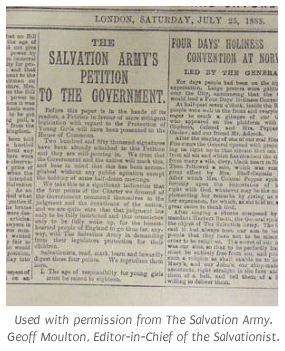 There were hundreds, perhaps thousands of organizations intent on doing good for others in the Victorian Era; it’s heartening, and perhaps a little convicting, to see how many people were dedicated to lifting the misery of others. In this book, though, I focused not only on the Theatrical Mission (which really did exist!) but drew inspiration from the Salvation Army, a vibrant organization for good in London and, eventually, the entire world. All the best parts of the ministries of The Cause, in this book, were inspired by the work of the Salvation Army, a powerful tour de force for good in Victorian England. The news clippings I had Gillian read from her mother’s scrapbooks were nearly exactly reproduced from actual clippings about the Salvation Army during the mid- to late- nineteenth century.
There were hundreds, perhaps thousands of organizations intent on doing good for others in the Victorian Era; it’s heartening, and perhaps a little convicting, to see how many people were dedicated to lifting the misery of others. In this book, though, I focused not only on the Theatrical Mission (which really did exist!) but drew inspiration from the Salvation Army, a vibrant organization for good in London and, eventually, the entire world. All the best parts of the ministries of The Cause, in this book, were inspired by the work of the Salvation Army, a powerful tour de force for good in Victorian England. The news clippings I had Gillian read from her mother’s scrapbooks were nearly exactly reproduced from actual clippings about the Salvation Army during the mid- to late- nineteenth century.
The Salvation Army was founded in 1865 by William Booth and his wife, Catherine. Both William and his wife Catherine preached, though William generally reached out to the poor and undesirables they felt led to minister to, including prostitutes, alcoholics and morphine addicts, and the destitute, and Catherine raised funds from the wealthy. Their many children eventually joined them in ministry, and one son, Bramwell, was drawn to the cause of the exploitation of children. From the Salvation Army’s website: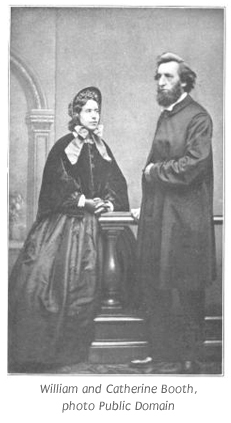
“The law, as it stood in the early 1880s, said that a girl of thirteen was legally competent to consent to her own seduction. Girls under the age of eight were not allowed to give evidence against those who had abused them, as it was thought that they were too young to understand the oath. Josephine Butler, a campaigner for women’s rights, wrote a letter to Florence Booth, the wife of The Salvation Army’s Chief of the Staff, Bramwell Booth, concerning the sale of young girls into prostitution. We have this letter and other correspondence relating to the case, including letters written by Catherine Booth, The Army Mother, to Queen Victoria.
Florence Booth, as pioneer leader of the Army’s Women’s Social Work, had gained an insight into the lives of girls working as prostitutes. Through this work, the practice of trafficking girls to be used for immoral purposes, both in Britain and overseas, came to the attention of The Salvation Army. Bramwell Booth had walked the streets of London, seeing for himself the desperate situations that many of the young girls found themselves in. What he saw prompted him to speak with W. T. Stead, Editor of the Pall Mall Gazette.
Stead was an admirer of The Salvation Army and was horrified to think that young girls were being bought and sold. He investigated the claims made by The Salvation Army and published his findings in the Pall Mall Gazette, 6-10 July 1885. The articles appeared under the title, ‘The Maiden Tribute of Modern Babylon’, and Stead received much support. On 14 August 1885, the Criminal Law Amendment Act became law, raising the age of consent from thirteen to sixteen years.”
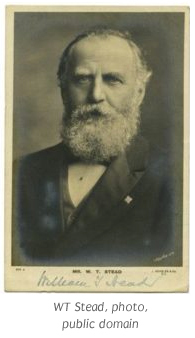 Stead has been said to have been heavily influenced by his mother, an early crusader for the proper treatment of all women, including prostitutes. Sadly, after helping women and children into lifeboats and giving away his life jacket, Mr. Stead was among the victims of the sinking of the Titanic; his valor persisted till the end of his days.
Stead has been said to have been heavily influenced by his mother, an early crusader for the proper treatment of all women, including prostitutes. Sadly, after helping women and children into lifeboats and giving away his life jacket, Mr. Stead was among the victims of the sinking of the Titanic; his valor persisted till the end of his days.
March 20, 2017
Enter the Raffle!
This week my new book, A Lady in Disguise, launches, and we are hoping to spread the word. Because word of mouth and finger strokes on social media are two of the best ways to spread the news about books, the way to enter the Rafflecopter drawing is by doing just that. If you’d like to join in, please click on the Rafflecopter, below, to learn about ways you might lend some muscle and enter into the drawing. Questions? Please contact Rel Mollet at authorsupport@relzreviewz.com if you have any questions about how to enter or what is required.
What do our prizes include? I’m glad you asked!
*One winner will receive the A Lady in Disguise Tea Prize Pack, inclusive of: Tea Hamper; Harney and Sons Earl Grey Supreme Tea Sachets; Fortnum and Mason Rose and Violet Cremes; Corset Tea Cup; Cameo Bookmark; Two Pencils from Buckingham Palace; One Package of Premium Floral Tea Syrups; Mad Libs Classics (including works by Jane Austen, Shakespeare, etc.); One Pack of Dainty Paper Tea Cake Plates.
*One winner will receive the A Lady in Disguise Fashion Prize Pack, inclusive of: 50-piece Colored Pencil and Sharpener Set; Late Victorian and Edwardian Fashions Adult Coloring Book; Godey’s Fashions Adult Coloring Book; Three Victorian Fashion Greeting Cards; One Cavendish and Harvey Sour Cherry Drops and One Original Gin-Gins.
When you click to enter, please be sure to scroll left and right to view both prizes!
a Rafflecopter giveaway
Rafflecopter T&Cs
By completing this form, you agree that you are 13 years or older. All information will remain confidential and will not be sold or otherwise used, except to notify you if you win and to facilitate postage of the prize to the winner.
The draw is open to residents of the USA only, due to varying regulations, and is void where prohibited. Enjoy!
A Lady in Disguise Giveaway!
I would love to introduce you to this wonderful London Lady. Let’s have a little fun while we do it, shall we? Here is an online Victorian name generator. Simply put your name into the boxes, and press random name generator. See what comes up. You can add a title if you like – Lady, Duchess, Miss, Mrs. Run your name and place the results in the comments below. Renee will draw one name, and that winner will receive a signed copy of A Lady in Disguise!
Victorian Name Generator – Click
Coronation Chicken Salad
To celebrate the book launch for A Lady in Disguise, I am going to eat a meal I truly love – Coronation Chicken Salad. Per that fine bastion of collective intelligence, Wikipedia, “Constance Spry, an English food writer and flower arranger, and Rosemary Hume, a chef, both principals of the Cordon Bleu Cookery School in London, are credited with the invention of coronation chicken. Preparing the food for the banquet of the coronation of Queen Elizabeth II in 1953, Spry proposed the recipe of cold chicken, curry cream sauce, and dressing that would later become known as coronation chicken.
“Coronation chicken may have been inspired by Jubilee chicken, a dish prepared for the silver jubilee of George V in 1935, which mixed chicken with mayonnaise and curry. Additionally, for the Queen’s Golden Jubilee in 2002, another celebratory dish was devised, also called Jubilee chicken.”
Try this delightful recipe that’s a twist on a classic U.K. dish – and you can substitute rotisserie chicken meat to make it even easier! Let me know what you think!
February 7, 2017
Bits and Bobs on Victorian Pantomimes
Pantomimes grew to be increasingly popular and elaborate forms of theatrical entertainment in the Victorian era. Dictionary.com describes pantomimes as, “a theatrical entertainment, mainly for children, that involves music, topical jokes, and slapstick comedy and is based on a fairy tale or nursery story, usually produced around Christmas.”
Because they were centered around Christmas and fairy-tales, a visit to a pantomime around Christmas time became a popular form of entertainment for families with children. Often overlooked, though, were the children that performed in them. Because there were so many poor families, and children, they and their parents clamored for the jobs, as shown in the handbill attached to this post.
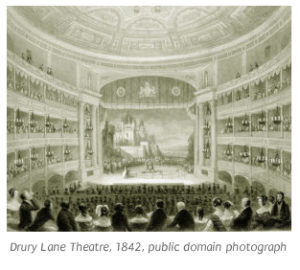 In an article found at the Victoria and Albert Museum website, one can learn that there were sometimes over 600 actors in a given pantomime—all needing costumes—and that during the Christmas holidays sometimes two performances a day would be put on. That is a lot of work, especially for children. The V and A tells us that, “The most elaborate Victorian pantomimes were at Drury Lane Theatre in London.”
In an article found at the Victoria and Albert Museum website, one can learn that there were sometimes over 600 actors in a given pantomime—all needing costumes—and that during the Christmas holidays sometimes two performances a day would be put on. That is a lot of work, especially for children. The V and A tells us that, “The most elaborate Victorian pantomimes were at Drury Lane Theatre in London.”
The Christmas, 1883 pantomime at the Theatre Royal, Drury Lane, really was Cinderella as I have portrayed it in A Lady in Disguise, and my son was able to locate a copy of the actual script so, for the most part, the words drawn from that performance are the ones that were spoken.
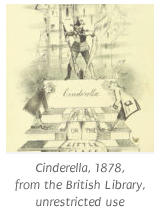 About this same time, a woman named Ellen Barlee took up the cause of the Pantomime Waifs, as they were known, pointing out that they were often exploited as child laborers. She exposed that the children were not being educated, and given the negative public sentiment about actresses (who were thought to have low morals) the girls themselves had a difficult time finding employment when they were no longer children. Barlee worked tirelessly to help the girls develop wholesome domestic skills that they might use to find employment later, rather than being further exploited.
About this same time, a woman named Ellen Barlee took up the cause of the Pantomime Waifs, as they were known, pointing out that they were often exploited as child laborers. She exposed that the children were not being educated, and given the negative public sentiment about actresses (who were thought to have low morals) the girls themselves had a difficult time finding employment when they were no longer children. Barlee worked tirelessly to help the girls develop wholesome domestic skills that they might use to find employment later, rather than being further exploited.
There was a theatrical mission on King Street, in the theatre district, during that era, which reached out to actresses, actors, and pantomime waifs. Because prostitution, including child prostitution, was common during the Victorian Era, too, people of good heart sought ways to protect the vulnerable from exploitation.
Sarah Gordon – Modern Day Costume Mistress
Sarah Gordon, Resident Costume Designer, and Costume Shop Manager, or better known as Grand Empress of Costumeland, was a super help to me as I sought to understand theater costumers then, and now before and while writing A Lady in Disguise. Sarah showed me around her theater (Taproot) and her workshop, explained how costumers and dressmakers work, and answered my many pesky questions. You’ll notice her little cameo in the book– well-deserved! Below, learn what it’s like to be a modern-day costume mistress!
What led you to want to be a costumer? What was your career path like?
I have always loved fashion and clothing and history. When I went to college- I was a double major in theater (emphasis in acting, because that is what you do in college, mostly because you don’t know better yet) and in Art History. We were all required to take design courses, and I showed enough promise that the Design faculty offered me scholarships to switch. By the end of undergrad, I was getting a BFA in Theatrical Design and Technology with an Art History Minor. I went to graduate school at Temple University for my MFA in costume design.
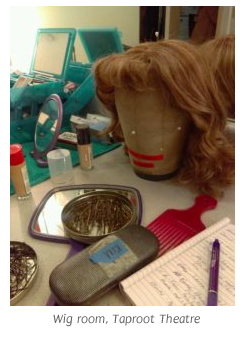 When you are designing a costume for an actress or an actor, what kinds of things are you thinking about? I usually start with- who is this character? Why are they the way that they are? What are the challenges in their lives? How do these challenges manifest in their clothing? Where would this character buy their clothes? Are they interested in clothing? Could they care less? Why? Does their character change during the play in a way that can be supported through the clothing choices?
When you are designing a costume for an actress or an actor, what kinds of things are you thinking about? I usually start with- who is this character? Why are they the way that they are? What are the challenges in their lives? How do these challenges manifest in their clothing? Where would this character buy their clothes? Are they interested in clothing? Could they care less? Why? Does their character change during the play in a way that can be supported through the clothing choices?
On a practical level- I am looking at the period, how many changes, how many wigs? Does the actor have foot issues that make finding shoes hard? Do they have any physical limitations that would keep them from being able to do quick changes? Through costumes and make-up, we help tell the story of who this particular character is and who they become through the course of the play by “manipulating” their appearance.
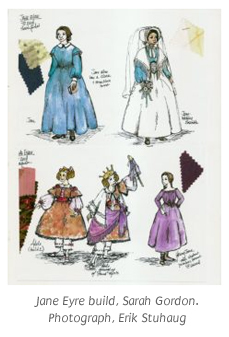 Take us through the process of a “build.” I usually start the year before the play with a rough costume plot which tells me how many costumes each character has. Then I am usually designing the show for at least six months prior to when rehearsals start. Our costume builds begin 3-5 weeks out from first dress rehearsal. That is when we bring in the cutter/drapers/first hands, who are the people who work with me to create the patterns and run the build. We will bring in the stitchers a few days later who are doing the actual sewing.
Take us through the process of a “build.” I usually start the year before the play with a rough costume plot which tells me how many costumes each character has. Then I am usually designing the show for at least six months prior to when rehearsals start. Our costume builds begin 3-5 weeks out from first dress rehearsal. That is when we bring in the cutter/drapers/first hands, who are the people who work with me to create the patterns and run the build. We will bring in the stitchers a few days later who are doing the actual sewing.
The cutter/draper then adjusts the pattern accordingly, and we begin building the garment for real- we usually have another fitting to finalize things before we do all the finishing work which includes trim, hems and closures. We still sometimes have notes on garments throughout the dress rehearsal process.
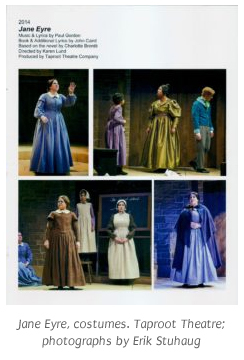 What are some cool costume tricks, like the one you share with me about using felt soled shoes? The felt-soled shoes were for Dracula. We wanted the character of Dracula to be “sneaky”- he needed to magically “appear” places. It’s hard to buy into the “magic” if you hear the actors clomping around- so we purchased suede-soled dance shoes for him- because they were quiet and he couldn’t be heard when he walked.
What are some cool costume tricks, like the one you share with me about using felt soled shoes? The felt-soled shoes were for Dracula. We wanted the character of Dracula to be “sneaky”- he needed to magically “appear” places. It’s hard to buy into the “magic” if you hear the actors clomping around- so we purchased suede-soled dance shoes for him- because they were quiet and he couldn’t be heard when he walked.
Other tricks? We spray straight vodka on most dry-cleanables in between our dry-cleaning runs (every two weeks) – this slows down the stinky – so to speak. We do a lot of rigging in most shows for quick changes- lots of elastic, Velcro and snaps that most people never know are there.
What is the best part about your job? The worst?
I love doing the research and discovering who the character is to bring together a design. I love working with a team to create garments that are more beautiful than anything I can do on my own. I enjoy the intimacy of working with actors and backstage crew. I love making hats. That is my specialty – I do love a good hat. Sometimes, having to be at the mercy of everyone else’s schedule is very tiring…I am often here late most nights during a build for fittings, before the 70 hour weeks of tech even start.
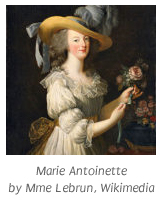 If you could dress any part, from all time, what would it be? Hmm. This one is tricky. I am a fan of the late 18th century – round gowns and such, but no big panniers for me, please- too hard to get through doors. I like lots of other periods, but most women’s clothing throughout time has been so restrictive (unless you were lower, working class- then you might be out of fashion so you could get your work done) and I am a fan of comfort. I like a lot of what Marie Antoinette brought to fashion- particularly in her “shepherdess” days…but I am pretty content to dress as myself for the most part.
If you could dress any part, from all time, what would it be? Hmm. This one is tricky. I am a fan of the late 18th century – round gowns and such, but no big panniers for me, please- too hard to get through doors. I like lots of other periods, but most women’s clothing throughout time has been so restrictive (unless you were lower, working class- then you might be out of fashion so you could get your work done) and I am a fan of comfort. I like a lot of what Marie Antoinette brought to fashion- particularly in her “shepherdess” days…but I am pretty content to dress as myself for the most part.
January 23, 2017
Classic Tomato Soup
Tomato Soup is a classic favorite of so many! I love it with cheese curds or chunks of cheddar melting within like hidden treasures, and partnered with Saltines. Follow the link below to learn how to make this creamy and delicious soup for you and your family. Then let me know what you think!
The One Year Home and Garden Devotions giveaway!
I love starting out a new year with new books – and one kind of January book I love is devotionals. I’ve had the privilege of writing three One Year Devotionals for Tyndale House (the third one is scheduled for 2018 publication!) and I’d love to send one of my Home and Garden Devotionals to two of my readers. Interested? Tell me, below, what you best love to do to comfort others, and what most comforts you when life turns a little chilly. Renee will draw a name from among the comments below, and I’ll ship a signed copy of the book off to the winners asap!
January 8, 2017
What is a Gothic Romance?
An interview with Sandra by Jenny Quinlan, of Let Them Read Books.
Jenny: What inspired you to take on the Gothic genre?
Sandra: I love reading old-school Gothic Romances such as those written by Victoria Holt, but I found it difficult to find many new ones that were still written with the “traditional ingredients.”
 As an author, I also wanted to update the concept a little for modern readers. I like more of the hero on the page than was present in quite a few of the gothic romance novel of years past, and I like my heroines to be a little bit less waifish and a little stronger minded than was popular then. I wanted to include just a wee bit more hard history, and I like weaving in an element of faith. But I tried my best to stick to the elements readers expect from a Gothic Romance, which include:
As an author, I also wanted to update the concept a little for modern readers. I like more of the hero on the page than was present in quite a few of the gothic romance novel of years past, and I like my heroines to be a little bit less waifish and a little stronger minded than was popular then. I wanted to include just a wee bit more hard history, and I like weaving in an element of faith. But I tried my best to stick to the elements readers expect from a Gothic Romance, which include:
• A large country house in need of attention and affection, already in disrepair. In some ways, the house represents the heroine.
• A Byronic hero, who might be questionable and always conflicted. The heroine falls in love, but she has to know before she commits – will he prove true?
• Characters—especially servants, but others, too—that may be untrustworthy; our heroine does not know and must puzzle it out.
• Psychological underpinnings, perhaps including madness or a suspicion of it.
• A supernatural element, whether naturally explained or not.
• Parents who are completely out the picture, or dead, so the heroine must rely on her own wits and resources.

Jenny: Women in the Victorian Era were defined and constrained by strict social mores and expectations. Can you talk a bit about creating a heroine from that era that today’s readers can still identify with? Sandra: All of us are constrained in some ways from the full self-determination we would prefer. There are always roadblocks, prejudices, laws that do not work in our favor, spiteful people, or situations that bring sorrow and which are completely out of our control. And yet … the human spirit, a strong woman’s spirit, faces those challenges head on, tries to think through what she wants, and then plots a way toward it. When roadblocks occur, she finds a way over, around, or through. That was true a thousand years ago and is still true, now.
Sandra: All of us are constrained in some ways from the full self-determination we would prefer. There are always roadblocks, prejudices, laws that do not work in our favor, spiteful people, or situations that bring sorrow and which are completely out of our control. And yet … the human spirit, a strong woman’s spirit, faces those challenges head on, tries to think through what she wants, and then plots a way toward it. When roadblocks occur, she finds a way over, around, or through. That was true a thousand years ago and is still true, now.
The very freedom of our age (for example, to work if we wish) has wrought a new set of challenges. But we still find a way to triumph. Seeing women do that, then, encourages me as a woman to do that, now. If they can be contenders, so can I!
 Jenny: How does your faith shape the inspirational aspects of your fiction? Sandra: My faith is central to my worldview and interests, so it informs the subjects I pursue in my books. Honestly, it would be anachronistic to write about 19th Century England and not have any mention of or interaction with faith; it was completely integrated into daily and weekly life. I don’t seek to write “Christian fiction” so much as it interests me how a strong Christian woman approaches a situation in her era and setting. I don’t set out, ever, in fiction, to teach, only to show and reveal and understand through the heroine’s eyes. Hopefully, that makes for a good, engaging read whether the reader is a Christian or not!
Jenny: How does your faith shape the inspirational aspects of your fiction? Sandra: My faith is central to my worldview and interests, so it informs the subjects I pursue in my books. Honestly, it would be anachronistic to write about 19th Century England and not have any mention of or interaction with faith; it was completely integrated into daily and weekly life. I don’t seek to write “Christian fiction” so much as it interests me how a strong Christian woman approaches a situation in her era and setting. I don’t set out, ever, in fiction, to teach, only to show and reveal and understand through the heroine’s eyes. Hopefully, that makes for a good, engaging read whether the reader is a Christian or not!
December 13, 2016
Blind Date with a Book Winner!!
Ann Badder was the winner of our Blind Date with a Book … keep opening your newsletters. We’ll do this again next year!



